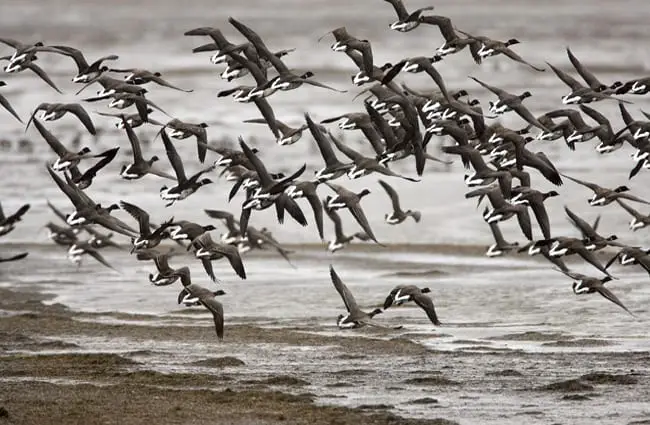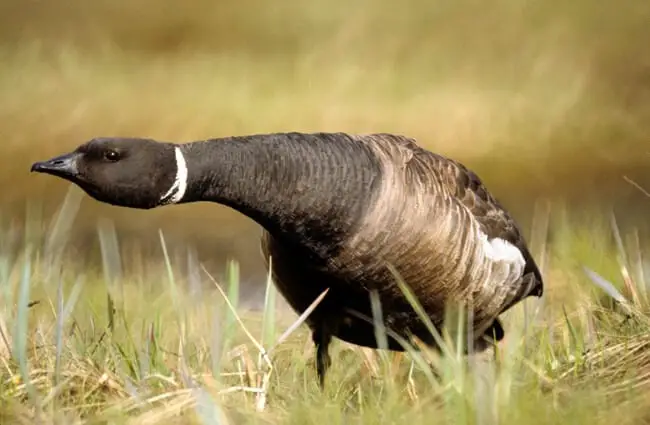The Remarkable Brant: A Deep Dive into the Life of a Coastal Goose
The Brant is a small goose that carries a big personality. Often overlooked in favor of larger, more boisterous cousins, it has a fascinating history, intricate behaviors, and a vital role in the ecosystems it inhabits. This guide explores the Brant’s biology, habitat, life cycle, and its interactions with both the natural world and humankind.

Identifying the Brant
The Brant, scientifically known as Branta bernicla, is a relatively small goose. Individuals measure between 56 and 70 centimeters in length and weigh from 0.8 to 1.5 kilograms. The most striking feature is its black head and neck, sharply contrasting with white cheek patches. The body is grayish‑brown, with a white belly. Immature birds display mottled brown plumage that gradually shifts to adult coloration. Size and subtle plumage details distinguish the Brant from other geese. It is noticeably smaller than the Canada Goose, and its facial markings are unique.
Habitat and Distribution
Brant populations are spread across a wide geographic range, with distinct groups inhabiting North America, Europe, and Asia. In North America, the Brant is primarily found along the Pacific and Atlantic coasts. The Pacific Brant breeds in Alaska and Siberia, migrating south to spend the winter along the coastal regions of California, Baja California, Oregon, and Washington. Atlantic Brant breed in northern Canada and Alaska, then winter along the Atlantic coast from Newfoundland to North Carolina. These birds are highly adapted to coastal environments, favoring salt marshes, estuaries, and mudflats where they forage for food.

Diet and Foraging Behavior
Unlike many geese that graze primarily on grasses, the Brant has a specialized diet that consists largely of marine vegetation, especially eelgrass and sea lettuce. This preference for aquatic plants shapes its foraging behavior. Brants often forage in shallow water, uprooting plants with their bills or grazing directly on submerged vegetation. Their diet also includes small invertebrates, providing essential proteins and nutrients. This dietary specialization makes them an important indicator species for the health of coastal ecosystems.
Evolutionary History
The evolutionary origins of the Brant, like all waterfowl, trace back to the family Anatidae, which includes ducks, geese, and swans. Fossil records indicate that Anatidae first appeared during the Miocene, about 23 to 35 million years ago. The Brant lineage diverged from other goose species several million years ago, adapting to coastal habitats and developing its unique dietary preferences. Phylogenetic studies, based on DNA analysis, continue to refine our understanding of the Brant’s relationships with other waterfowl.
Life Cycle: Mating, Nesting and Raising Young
Brants are typically monogamous, forming pair bonds that often last for several years and sometimes for life. Mating occurs in spring, shortly after the birds arrive at their breeding grounds. Nests are usually built on the ground, concealed within vegetation near the coast. The female lays four to six eggs and incubates them for about 24 to 28 days. Both parents participate in caring for the young, protecting them from predators and guiding them to foraging areas. Goslings are precocial, meaning they are relatively independent at birth; they can walk, swim, and feed themselves shortly after hatching. The family group remains together throughout the summer, then gradually disperses as the birds prepare for southward migration.

Brant and the Ecosystem
Brants play a vital role in the coastal ecosystems they inhabit. As grazers, they help maintain the health and diversity of eelgrass beds and salt marshes. Their foraging activities stimulate plant growth and prevent the overgrowth of algae. Brants also serve as an important food source for predators such as foxes, owls, and other raptors. Their droppings contribute to nutrient cycling, enriching the soil and supporting plant growth. The health of Brant populations is therefore a key indicator of the overall health of coastal ecosystems. Interactions with other birds are complex: Brants sometimes compete for resources, yet they also join mixed flocks during migration and wintering periods.
Brant and Human Interaction
Historically, Brants were hunted by indigenous peoples along the coasts of North America and Europe for their meat and eggs. While hunting continues in some areas, it is now regulated to ensure sustainable populations. Habitat loss and degradation—caused by coastal development and pollution—pose significant threats to Brant populations. Climate change, leading to sea‑level rise and shifts in vegetation patterns, also presents a growing challenge. Conservation efforts, including habitat restoration, protected areas, and sustainable hunting practices, are crucial for ensuring the long‑term survival of the Brant.

Encountering Brant in the Wild
If you encounter Brants in the wild, observe them from a respectful distance and avoid disturbing their feeding or nesting activities. Do not feed them, as human food can be harmful to their health. Keep pets leashed to prevent them from harassing the birds. Report any injured or distressed birds to local wildlife authorities.
Caring for Brants in Captivity
Providing appropriate care for Brants in captivity requires a deep understanding of their natural history and behavioral needs. They need spacious enclosures with access to both land and water. Their diet should closely mimic their natural diet, consisting primarily of aquatic vegetation and supplemented with grains and protein sources. Enrichment activities—such as foraging opportunities and social interaction with other birds—are essential for maintaining their physical and mental wellbeing. Regular veterinary care, including vaccinations and parasite control, is also crucial.

Fascinating Brant Facts
Here are a few more intriguing details about the Brant:
- Brants are known for their strong migratory abilities, flying long distances between breeding and wintering grounds.
- Their bill is specially adapted for grazing on aquatic vegetation.
- Goslings can swim within hours of hatching.
- They communicate with a variety of vocalizations, including honking, whistling, and chirping.
- Some populations exhibit remarkable site fidelity, returning to the same breeding and wintering grounds year after year.

Conclusion
The Brant is a remarkable bird, a testament to the power of adaptation and the interconnectedness of life. Its specialized diet, migratory behavior, and vital role in coastal ecosystems make it a truly unique and valuable member of the avian world. By understanding and appreciating the Brant, we can contribute to its conservation and ensure that future generations continue to marvel at this elegant and resilient goose.

![Red Angus Closeup of a beautiful Red Angus cowPhoto by: U.S. Department of Agriculture [pubic domain]https://creativecommons.org/licenses/by/2.0/](https://animals.net/wp-content/uploads/2020/03/Red-Angus-4-238x178.jpg)




![Red Angus Closeup of a beautiful Red Angus cowPhoto by: U.S. Department of Agriculture [pubic domain]https://creativecommons.org/licenses/by/2.0/](https://animals.net/wp-content/uploads/2020/03/Red-Angus-4-100x75.jpg)

